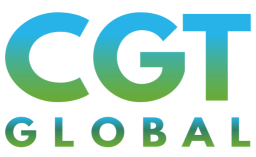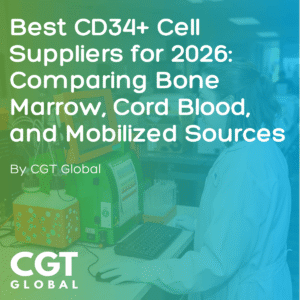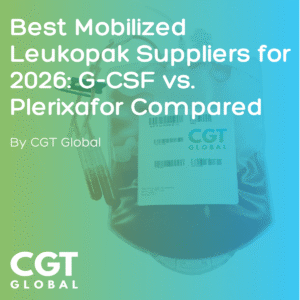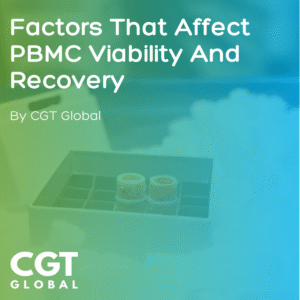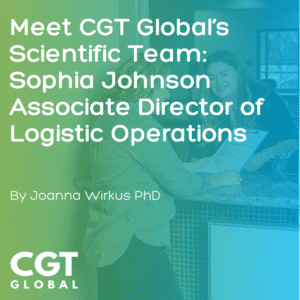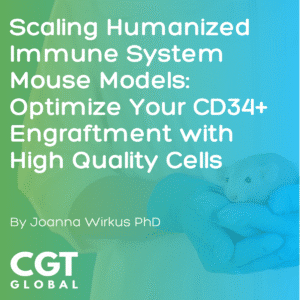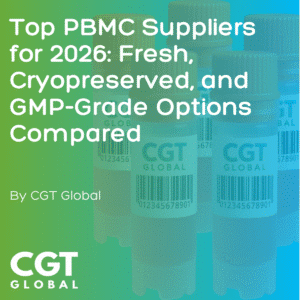By: Joanna Wirkus
Estimated reading time: 6 minutes
Table of contents
- Simple Steps to Significantly Improve Humanized Mice Engraftment Success
- Restarting hematopoiesis effectively with high engraftment rates
- For improving engraftment rates: choose the right cell sourcing collaborators
- From Cord Blood to Engraftment in 48 Hours: CGT Global’s Proven Process for Preclinical Success
- Citations
Simple Steps to Significantly Improve Humanized Mice Engraftment Success
Previously in “Overcoming Challenges with Animal Models in Research”, we covered why animal models with human immune systems have significantly improved the translation of preclinical findings into life-saving treatments. Successfully creating these advanced models for testing new therapies relies on high hematopoietic stem cell engraftment rates. By boosting engraftment rates, scientists can better model human diseases to advance drug development and immune system engineering. Low engraftment rates can lead to inconsistent results and unreliable therapeutic outcomes.
The first step to creating a humanized mouse model is the collection of CD34+ cells from donated human umbilical cord blood, bone marrow, or peripheral blood. These isolated stem and progenitor cells are then reintroduced into immune-depleted mice. Through a process called homing, the stem cells find their way from the circulation into the bone marrow. Once the cells adhere inside the bone, they establish their niche and begin to proliferate. Engraftment is successful when the hematopoietic stem cells divide, differentiate, and repopulate red and white blood cells into circulation. There are many challenges that can threaten reproducible stem cell engraftment in humanized mouse models including donor collection methods, cell isolation, and eventual cell infusion. When things go wrong and engraftment rates are low, the mouse model is not suitable for future studies. Obstacles like this can slow research due to unreliable results, inadequate sample sizes, and wasted resources. Despite the challenges, obtaining high engraftment rates for experimental success is possible with our latest scientific understanding of stem cell biology, better cell collection methods, and refined laboratory processing techniques.
Restarting hematopoiesis effectively with high engraftment rates
The success of the new graft relies on starting with a high number of healthy cells. How to achieve higher engraftment rates:
- Protocol Optimization: The journey of the cells from collection to infusion is arduous. CD34+ cells are scarce and must be handled with care to remain viable and functional throughout harvest, storage, and re-establishment into the host. For the process to be successful, all biospecimen collection and cell processing protocols must be optimized to avoid unnecessary stress to the cells.
- Proper Cell Dosage: If the cell dosage is too low, the new cells will not engraft properly, leading to delayed recovery. Clinical research has linked higher CD34+ cell counts at cryopreservation with the speed of hematopoietic recovery.
- Customized Protocols for Diseased Donors: Collecting cells from donors with underlying health conditions requires protocol modifications to ensure donor safety and scientific integrity. Diseased-state cells behave differently, requiring adjustments in collection procedures, processing methods, and dosing strategies.
- Quality of Starting Cellular Material: Cell counts and cell viability are two parameters that can influence the success of downstream experiments. Sourcing cells from a quality vendor with validated methods to enhance the number of functional cells is a valuable and often overlooked investment.
For improving engraftment rates: choose the right cell sourcing collaborators
Umbilical cord blood is a rich source of CD34+ stem cells that carry a lower risk of graft-versus-host-disease. Along the journey from harvest to infusion, many factors can lead to better overall cell health and eventual engraftment.
- Prompt Collection: Collecting cord blood as soon as possible after birth leads to higher cell productivity.
- Skill and Experience: Highly trained medical staff execute proper collection techniques to ensure the highest volume and quality of blood from each cord. Our laboratory technicians are experts in cell isolation and cryopreservation.
- Speed of Processing: Cord blood should be processed within hours of collection, and CD34+ cells should be isolated within 8 hours for optimal cell procurement.
From Cord Blood to Engraftment in 48 Hours: CGT Global’s Proven Process for Preclinical Success
Successful engraftment in humanized mouse models starts with more than just high-quality cells — it starts with a partner who understands the importance of speed, consistency, and precision. At CGT Global, we’ve perfected a streamlined process that takes you from cord blood collection to engraftment in under 48 hours.
Our End-to-End Workflow:

- Cord Blood Collection
Within moments of birth, cord blood units are collected by trained medical staff at our partner hospitals — ensuring optimal stem cell viability and yield. - CD34+ Cell Isolation (<24 Hours)
Samples are immediately processed in our state-of-the-art labs, where expert technicians use validated protocols to isolate CD34+ stem cells with maximum purity and viability. - Cryopreservation or Fresh Shipment
Isolated cells are either cryopreserved using controlled-rate freezing or shipped fresh in temperature-controlled containers — tailored to your project’s needs. - Infusion into Mice (<48 Hours)
For time-sensitive studies, fresh cells can be delivered and infused into mice within 48 hours of collection, significantly improving engraftment rates. - Engraftment Success with Confidence
Our multi-vial lots from the same donor ensure consistent cell counts, high viability, and reduced variability — so your humanized models are reproducible and reliable.
Why Researchers Trust CGT Global
We don’t just deliver cells — we deliver confidence. With 15+ years of experience, CGT Global has supported leading global humanized mouse model companies with high-engraftment CD34+ cells sourced from healthy and disease-state donors. Our labs produce custom, quality-controlled lots, backed by logistics expertise and a deep commitment to supporting oncology, immunology, and cell and gene therapy research.
When you choose CGT Global, you get:
- Faster study starts, fewer failed models, and higher reproducibility
- One of the largest donor networks and thousands of cord blood units collected each year
- Pre-screened, pre-isolated cells that are experiment-ready
Read more about our cord blood collection methods and how CGT Global isolates CD34+ cells from umbilical cord blood within hours of birth.
Citations
Konuma, T., Kato, S., Oiwa-Monna, M., Tanoue, S., Ogawa, M., Isobe, M., Tojo, A., and Takahashi, S. (2017). Cryopreserved CD34+ Cell Dose, but Not Total Nucleated Cell Dose, Influences Hematopoietic Recovery and Extensive Chronic Graft-versus-Host Disease after Single-Unit Cord Blood Transplantation in Adult Patients. Biol. Blood Marrow Transplant. 23, 1142–1150. 10.1016/j.bbmt.2017.03.036.
Lapidot, T., Dar, A., and Kollet, O. (2005). How do stem cells find their way home? Blood 106, 1901–1910. 10.1182/blood-2005-04-1417.
Ng, E.S., Sarila, G., Li, J.Y., Edirisinghe, H.S., Saxena, R., Sun, S., Bruveris, F.F., Labonne, T., Sleebs, N., Maytum, A., et al. (2024). Long-term engrafting multilineage hematopoietic cells differentiated from human induced pluripotent stem cells. Nat. Biotechnol. 10.1038/s41587-024-02360-7.
Remberger, M., Törlén, J., Ringdén, O., Engström, M., Watz, E., Uhlin, M., and Mattsson, J. (2015). Effect of Total Nucleated and CD34(+) Cell Dose on Outcome after Allogeneic Hematopoietic Stem Cell Transplantation. Biol. Blood Marrow Transplant. 21, 889–893. 10.1016/j.bbmt.2015.01.025.
Spitzer, T.R. (2015). Engraftment syndrome: double-edged sword of hematopoietic cell transplants. Bone Marrow Transplant. 50, 469–475. 10.1038/bmt.2014.296.
